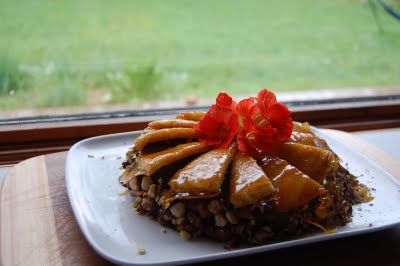 I must admit, this almost didn’t happen. Life has picked up a couple of notches, and I found myself beginning to imagine the reality of skipping the first Daring Baker’s challenge since I joined up almost a year ago. The other morning, I had all of my ingredients lined up, and I was still trying to back out, weaseling my way through excuses. Luckily, Donovan is visiting. And we all know how daring she is- remember when she stole those lemons for me? “Oh Alana, it wouldn’t be a challenge if there wasn’t a struggle there.”
I must admit, this almost didn’t happen. Life has picked up a couple of notches, and I found myself beginning to imagine the reality of skipping the first Daring Baker’s challenge since I joined up almost a year ago. The other morning, I had all of my ingredients lined up, and I was still trying to back out, weaseling my way through excuses. Luckily, Donovan is visiting. And we all know how daring she is- remember when she stole those lemons for me? “Oh Alana, it wouldn’t be a challenge if there wasn’t a struggle there.”
Okay, okay. I’m starting to sift flour, albeit with some major resistance, waiting for some family emergency to take me away from the project.
Then my mother called. My aunt and uncle were in town and the whole family was coming over for dinner.
Me: Hi Mom. I’ll be making a complicated cake for the next six hours or so.
Mom: What? It’s so hot today! So miserable! So humid! Did you know we’ll reach 100 percent humidity tonight? Make it later in the week, when it’s cooler.
Me: Hell no! I’m excited to make this cake! In fact, this is the perfect weather to make this cake! Come over tonight, and there will be cake!
Now, do you see how that went? My mother and I are great friends, and she is one of my favorite people. But like my mother (imagine that!) I tend to let the weather have perhaps more power than is necessary when it comes to my daily activities. And there’s nothing like a mother’s adversity to get me raring on a project. What am I, sixteen? Anyway, thanks Mom, for making this one happen.
A few notes on this cake before we begin. I have to admit that I wasn’t too excited starting out. The whole thing seemed that it might be too sweet for my tastes, and caramel doesn’t excite me. But there are a lot of cool things going on in this cake, and I took it as a good lesson, for which it was fabulous. It was also my first time making a real buttercream- a process way overdue.
I made this recipe exactly as it was written. I even used cake flour, which comes in a scary box with the word “BLEACHED” in big letters. Most of all, I figured out something that was more helpful than anything- I pinned up the recipe all over my kitchen. Check it out!
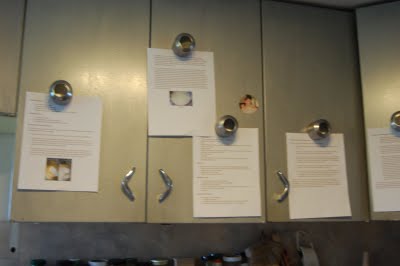 The August 2009 Daring Bakers’ challenge was hosted by Angela of A Spoonful of Sugar and Lorraine of Not Quite Nigella. They chose the spectacular Dobos Torte based on a recipe from Rick Rodgers’ cookbook Kaffeehaus: Exquisite Desserts from the Classic Caffés of Vienna, Budapest, and Prague.
The August 2009 Daring Bakers’ challenge was hosted by Angela of A Spoonful of Sugar and Lorraine of Not Quite Nigella. They chose the spectacular Dobos Torte based on a recipe from Rick Rodgers’ cookbook Kaffeehaus: Exquisite Desserts from the Classic Caffés of Vienna, Budapest, and Prague.
So here we go…
First, the ingredients:
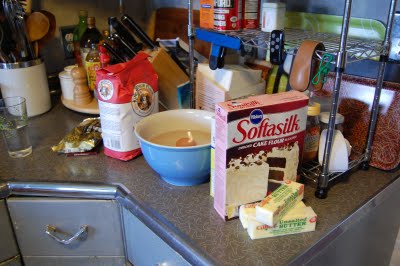 Sponge cake layers
Sponge cake layers
6 large eggs, separated, at room temperature
1 1/3 cups (162g) confectioner’s (icing) sugar, divided
1 teaspoon (5ml) vanilla extract
1 cup plus 2 tablespoons (112g) sifted cake flour (SUBSTITUTE 95g plain flour + 17g cornflour (cornstarch) sifted together
pinch of salt
Chocolate Buttercream
4 large eggs, at room temperature
1 cup (200g) caster (ultrafine or superfine white) sugar
4oz (110g) bakers chocolate or your favourite dark chocolate, finely chopped
2 sticks plus 2 tablespoons (250g) unsalted butter, at room temperature.
Caramel topping
1 cup (200g) caster (superfine or ultrafine white) sugar
12 tablespoons (180 ml) water
8 teaspoons (40 ml) lemon juice
1 tablespoon neutral oil (e.g. grapeseed, rice bran, sunflower)
Finishing touches
a 7” cardboard round
12 whole hazelnuts, peeled and toasted
½ cup (50g) peeled and finely chopped hazelnuts
Directions for the sponge layers:
NB. The sponge layers can be prepared in advance and stored interleaved with parchment and well-wrapped in the fridge overnight.
1.Position the racks in the top and centre thirds of the oven and heat to 400F (200C).
2.Cut six pieces of parchment paper to fit the baking sheets. Using the bottom of a 9″ (23cm) springform tin as a template and a dark pencil or a pen, trace a circle on each of the papers, and turn them over (the circle should be visible from the other side, so that the graphite or ink doesn’t touch the cake batter.)
3.Beat the egg yolks, 2/3 cup (81g) of the confectioner’s (icing) sugar, and the vanilla in a medium bowl with a mixer on high speed until the mixture is thick, pale yellow and forms a thick ribbon when the beaters are lifted a few inches above the batter, about 3 minutes. (You can do this step with a balloon whisk if you don’t have a mixer.)
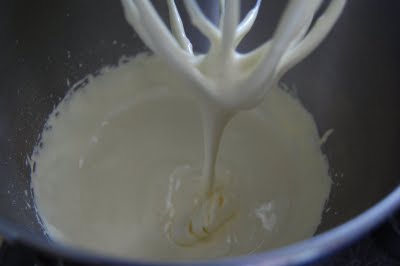 4.In another bowl, using clean beaters, beat the egg whites until soft peaks form. Gradually beat in the remaining 2/3 cup (81g) of confectioner’s (icing)sugar until the whites form stiff, shiny peaks. Using a large rubber spatula, stir about 1/4 of the beaten whites into the egg yolk mixture, then fold in the remainder, leaving a few wisps of white visible. Combine the flour and salt. Sift half the flour over the eggs, and fold in; repeat with the remaining flour.
4.In another bowl, using clean beaters, beat the egg whites until soft peaks form. Gradually beat in the remaining 2/3 cup (81g) of confectioner’s (icing)sugar until the whites form stiff, shiny peaks. Using a large rubber spatula, stir about 1/4 of the beaten whites into the egg yolk mixture, then fold in the remainder, leaving a few wisps of white visible. Combine the flour and salt. Sift half the flour over the eggs, and fold in; repeat with the remaining flour.
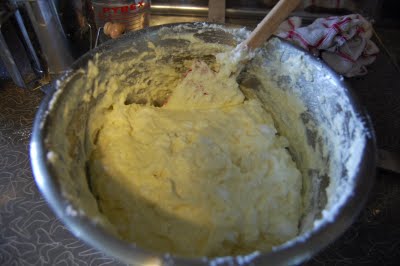 5.Line one of the baking sheets with a circle-marked paper. Using a small offset spatula, spread about 3/4cup of the batter in an even layer, filling in the traced circle on one baking sheet. Bake on the top rack for 5 minutes, until the cake springs back when pressed gently in the centre and the edges are lightly browned. (This one was too thin, and so too brown, but it was okay anyway).
5.Line one of the baking sheets with a circle-marked paper. Using a small offset spatula, spread about 3/4cup of the batter in an even layer, filling in the traced circle on one baking sheet. Bake on the top rack for 5 minutes, until the cake springs back when pressed gently in the centre and the edges are lightly browned. (This one was too thin, and so too brown, but it was okay anyway).
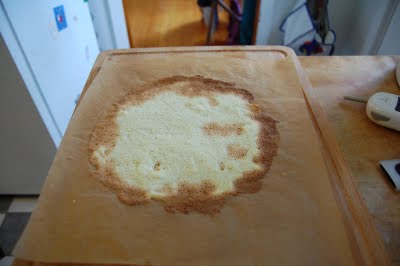 While this cake bakes, repeat the process on the other baking sheet, placing it on the center rack. When the first cake is done, move the second cake to the top rack. Invert the first cake onto a flat surface and carefully peel off the paper. Slide the cake layer back onto the paper and let stand until cool. Rinse the baking sheet under cold running water to cool, and dry it before lining with another parchment. Continue with the remaining papers and batter to make a total of six layers. Completely cool the layers. Using an 8″ springform pan bottom or plate as a template, trim each cake layer into a neat round. (A small serrated knife is best for this task.)
While this cake bakes, repeat the process on the other baking sheet, placing it on the center rack. When the first cake is done, move the second cake to the top rack. Invert the first cake onto a flat surface and carefully peel off the paper. Slide the cake layer back onto the paper and let stand until cool. Rinse the baking sheet under cold running water to cool, and dry it before lining with another parchment. Continue with the remaining papers and batter to make a total of six layers. Completely cool the layers. Using an 8″ springform pan bottom or plate as a template, trim each cake layer into a neat round. (A small serrated knife is best for this task.)
A Note here: Joey came out with a template that worked much better for me- the outside of an 8″ tart pan. Then you can cut around the inside of the pan. I’ll let Joey demonstrate…
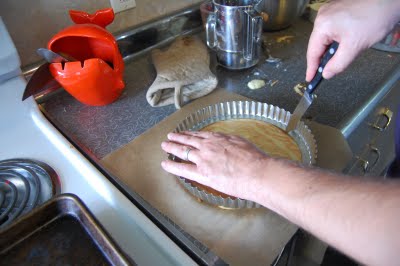 Directions for the chocolate buttercream:
Directions for the chocolate buttercream:
NB. This can be prepared in advance and kept chilled until required.
1.Prepare a double-boiler: quarter-fill a large saucepan with water and bring it to a boil.
2.Meanwhile, whisk the eggs with the sugar until pale and thickened, about five minutes. You can use a balloon whisk or electric hand mixer for this.
3.Fit bowl over the boiling water in the saucepan (water should not touch bowl) and lower the heat to a brisk simmer. Cook the egg mixture, whisking constantly, for 2-3 minutes until you see it starting to thicken a bit. Whisk in the finely chopped chocolate and cook, stirring, for a further 2-3 minutes.
NOTE: I’m thinking that I overcooked the buttercream. Everything was light and wonderful, and then in a moment, it was liquid. I went from this:
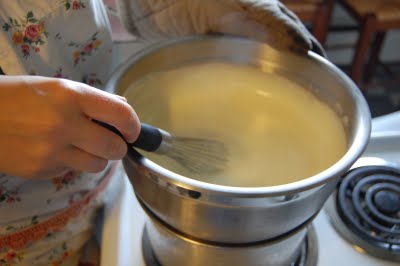 To this:
To this:
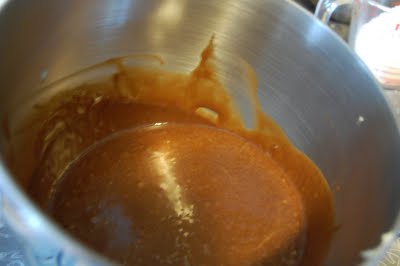 It still had a good flavor, and thickened in the fridge, but it wasn’t velvety at all.
It still had a good flavor, and thickened in the fridge, but it wasn’t velvety at all.
4.Scrape the chocolate mixture into a medium bowl and leave to cool to room temperature. It should be quite thick and sticky in consistency.
5.When cool, beat in the soft butter, a small piece (about 2 tablespoons/30g) at a time. An electric hand mixer is great here, but it is possible to beat the butter in with a spatula if it is soft enough. You should end up with a thick, velvety chocolate buttercream. Chill while you make the caramel topping.
Directions for the caramel topping:
1.Choose the best-looking cake layer for the caramel top. To make the caramel topping: Line a jellyroll pan with parchment paper and butter the paper. Place the reserved cake layer on the paper. Cut the cake into 12 equal wedges. Lightly oil a thin, sharp knife and an offset metal spatula.
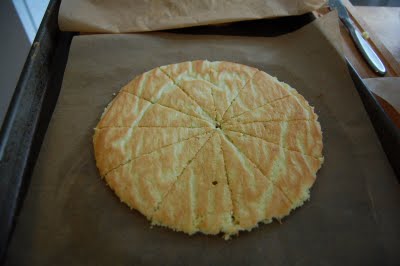 2.Stir the sugar, water and lemon juice in a small saucepan. Bring to a boil over a medium heat, stirring often to dissolve the sugar. Once dissolved into a smooth syrup, turn the heat up to high and boil without stirring, swirling the pan by the handle occasionally and washing down any sugar crystals on the sides of the pan with a wet brush until the syrup has turned into an amber-coloured caramel.
2.Stir the sugar, water and lemon juice in a small saucepan. Bring to a boil over a medium heat, stirring often to dissolve the sugar. Once dissolved into a smooth syrup, turn the heat up to high and boil without stirring, swirling the pan by the handle occasionally and washing down any sugar crystals on the sides of the pan with a wet brush until the syrup has turned into an amber-coloured caramel.
3.. Immediately pour all of the hot caramel over the cake layer. You will have some leftover most probably but more is better than less and you can always make nice toffee pattern using the extra to decorate. Using the offset spatula, quickly spread the caramel evenly to the edge of the cake layer. Let cool until beginning to set, about 30 seconds. Using the tip of the hot oiled knife (keep re-oiling this with a pastry brush between cutting), cut through the scored marks to divide the caramel layer into 12 equal wedges. Cool another minute or so, then use the edge of the knife to completely cut and separate the wedges using one firm slice movement (rather than rocking back and forth which may produce toffee strands). Cool completely.
Another trick here: Use scissors!
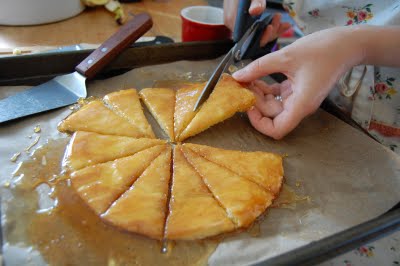 Assembling the Dobos
Assembling the Dobos
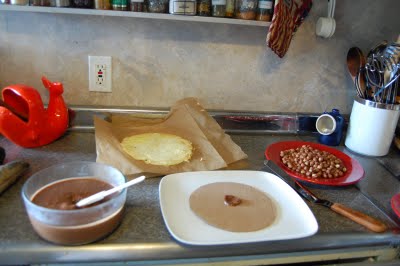 1.Divide the buttercream into six equal parts.
1.Divide the buttercream into six equal parts.
2.Place a dab of chocolate buttercream on the middle of a 7 1/2” cardboard round and top with one cake layer. Spread the layer with one part of the chocolate icing. Repeat with 4 more cake layers. Spread the remaining icing on the sides of the cake.
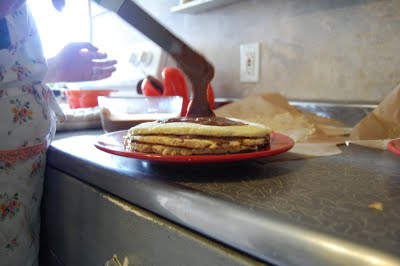 3.Optional: press the finely chopped hazelnuts onto the sides of the cake.
3.Optional: press the finely chopped hazelnuts onto the sides of the cake.
4.Propping a hazelnut under each wedge so that it sits at an angle, arrange the wedges on top of the cake in a spoke pattern. If you have any leftover buttercream, you can pipe rosettes under each hazelnut or a large rosette in the centre of the cake. Refrigerate the cake under a cake dome until the icing is set, about 2 hours. Let slices come to room temperature for the best possible flavor.
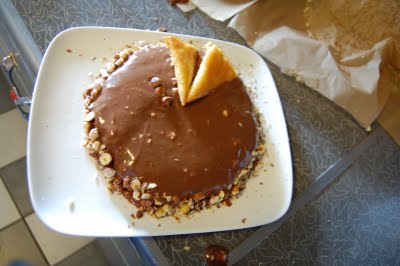 And how was it?
And how was it?
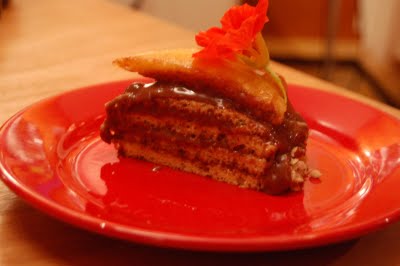 Too sweet for me. The caramel layer was, to quote Donovan, unkind. And too lemony. We discussed simply soaking the top layer in some sort of liquor, and I think that would have been much yummier. But I learned lots, and came out daring once again. Go check out the Daring Kitchen for more exciting Dobos tortes.
Too sweet for me. The caramel layer was, to quote Donovan, unkind. And too lemony. We discussed simply soaking the top layer in some sort of liquor, and I think that would have been much yummier. But I learned lots, and came out daring once again. Go check out the Daring Kitchen for more exciting Dobos tortes.
